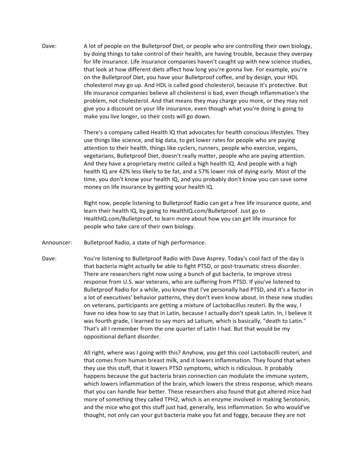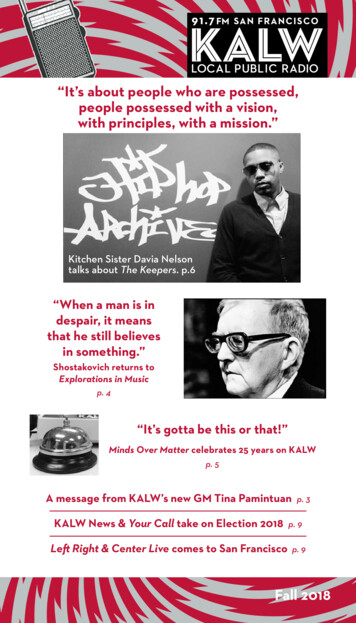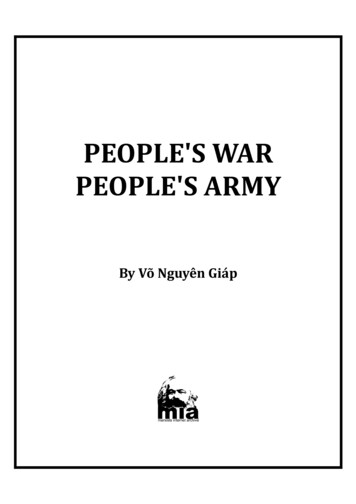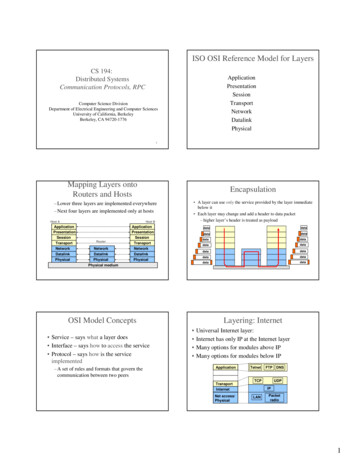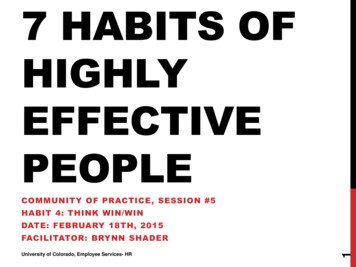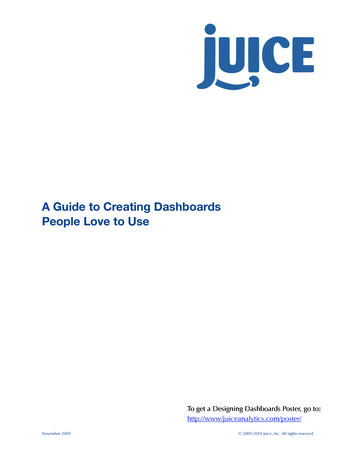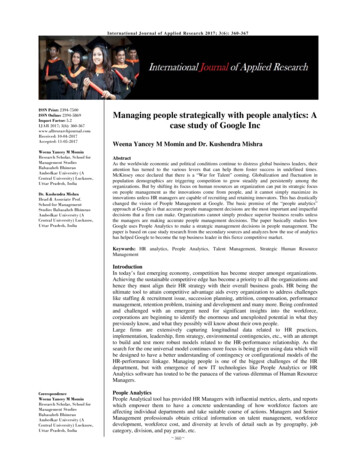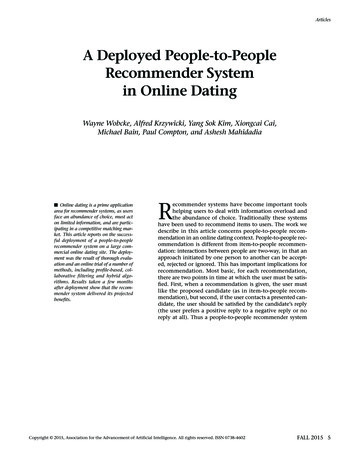
Transcription
ArticlesA Deployed People-to-PeopleRecommender Systemin Online DatingWayne Wobcke, Alfred Krzywicki, Yang Sok Kim, Xiongcai Cai,Michael Bain, Paul Compton, and Ashesh Mahidadia Online dating is a prime applicationarea for recommender systems, as usersface an abundance of choice, must acton limited information, and are participating in a competitive matching market. This article reports on the successful deployment of a people-to-peoplerecommender system on a large commercial online dating site. The deployment was the result of thorough evaluation and an online trial of a number ofmethods, including profile-based, collaborative filtering and hybrid algorithms. Results taken a few monthsafter deployment show that the recommender system delivered its projectedbenefits.Recommender systems have become important toolshelping users to deal with information overload andthe abundance of choice. Traditionally these systemshave been used to recommend items to users. The work wedescribe in this article concerns people-to-people recommendation in an online dating context. People-to-people recommendation is different from item-to-people recommendation: interactions between people are two-way, in that anapproach initiated by one person to another can be accepted, rejected or ignored. This has important implications forrecommendation. Most basic, for each recommendation,there are two points in time at which the user must be satisfied. First, when a recommendation is given, the user mustlike the proposed candidate (as in item-to-people recommendation), but second, if the user contacts a presented candidate, the user should be satisfied by the candidate’s reply(the user prefers a positive reply to a negative reply or noreply at all). Thus a people-to-people recommender systemCopyright 2015, Association for the Advancement of Artificial Intelligence. All rights reserved. ISSN 0738-4602FALL 2015 5
Articlesneeds to take into account the preferences of proposed candidates, who determine whether an interaction is successful, in addition to those of the user.People-to-people recommenders are thus reciprocalrecommenders (Pizzato et al. 2013). Or, putting thisfrom the point of view of the user, a people-to-people recommender system must take into accountboth a user’s taste (whom they find attractive) andtheir own attractiveness, so the presented candidateswill find them attractive in return, and give a positivereply (Cai et al. 2010).Using online dating sites can be difficult for manypeople. First, there is the stress of entering or reentering the dating market. Second, there are a variety ofdating sites with competing or confusing claims as totheir effectiveness in matching people with the perfect partner — a group of psychologists have recentlydrawn attention to the questionable validity of someof these claims (Finkel et al. 2012). Third, once joining a site, users may have to fill in a lengthy questionnaire or state preferences for their ideal partner,which can be daunting because if the user’s objectiveis to find a long-term partner, they surely know theywill have to compromise, but do not know at the outset what compromises they are likely to make. Fourth,as is well known, dating is a type of market, a matching market, where people compete for scarceresources (partners) and are, in turn, a resource soughtby others — see the recent user perspective of a labormarket economist on the dating market that exploresthis idea in depth (Oyer 2014). Finally, users are askedto provide a brief personal summary that must differentiate themselves from others on the site and attractinterest. It is difficult to stand out from the crowd:many people’s summaries appear cliché-ridden andgeneric, but according to at least one popularaccount, perhaps the main objective of the summaryis simply is to project an optimistic, carefree outlookthat creates a positive first impression and stimulatesfurther interest (Webb 2013).Once onsite, users are immediately overwhelmedwith an abundance of choice in potential partners.Moreover, they may also be the subject of intenseinterest from existing users now that their profile ispublic (often a site will heavily promote newly joinedusers). On most sites, users can choose from amongstthousands of others by sifting through galleries ofphotos and profiles. The most common way for usersto find potential contacts is by advanced search(search based on attributes, such as age, location,education, and occupation, and other keywords).Searches typically return many results, and it may bedifficult for users to decide whom to contact. As aresult, some users contact those whom they findmost attractive; however, this is a poor strategy forgenerating success, as those popular users thenbecome flooded with contacts but can reply positively to only a very small fraction of them.A basic problem for users is that it is hard for them6AI MAGAZINEto estimate their own desirability so as to choose contacts who are likely to respond positively, and similarly, it is impossible for them to know how muchcompetition they face when contacting another person, and hence to gauge their likely chance of success. In addition, after narrowing down searches byobvious criteria, profile information typically provides limited information to discriminate one userfrom another. This is why a recommender system canprovide much help to users of a dating site.The organization of this article is as follows. In thenext section, we outline the basic problems of recommendation in online dating and introduce ourkey metrics. Then we present our recommendationmethods, and discuss a live trial conducted with theaim of selecting one method for deployment on site(Selection of Recommender for Deployment). TheRecommender Deployment section contains detailsof the deployment process for the winning algorithm. A postdeployment evaluation of the method isthen provided, followed by lessons learned.Recommender SystemsOnline dating is a prime application area for recommender systems, as users face an abundance ofchoice, must act on limited information, and are participating in a competitive matching market. Interactions are two way (a user contacts another, andeither receives a positive or negative reply, or receivesno reply at all), and thus the recommendation of acandidate to a user must take into account the tasteand attractiveness of both user and candidate.Due to the limited amount of user information ononline dating sites (and, of course, users can misrepresent themselves to some extent to present themselves in a more favorable light), our recommendersystem does not aim to provide the perfect match.Rather, we adopt a probabilistic stance and aim topresent users with candidates who they will like andthat will increase their chances of a successful interaction. Moreover, success is defined narrowly as theuser receiving a positive reply to a contact they initiate. The main reason for this restrictive definition isthat, for the dating site we were working with, userscan make initial contact for no charge by sending amessage drawn from a predefined list, and replies(also free and from a predefined list) are predetermined (by the dating site company) as either positiveor negative, leaving no room for ambiguity. Thus wehave extremely reliable data for this notion of success. Users can initiate paid open communication toothers, with or without these initial contacts. However, the dating site company does not have any dataon the success of open communications, or any feedback from person-to-person meetings. Thus the typical user interaction sequence we focus on is illustrated in figure 1.A secondary objective of our recommender system
ArticlesHi there!“I'd like to get to know you, are you interested?”Free pre-definedcommunication“Thanks! I would like to hear from you.”Paid opencommunicationFigure 1. Typical User Interaction Sequence.is to increase overall user engagement with the site.If users become frustrated by being unable to findsuccessful interactions, they may leave the site,resulting in an increased attrition rate of users and areduced candidate pool. By providing opportunitiesfor successful interactions, a recommender systemcan help maintain a large candidate pool for othersto contact. The idea was that this could be achievedby designing the recommender system to promoteusers who would otherwise not receive much contact, increasing their engagement with the site.These considerations led us to define two key metrics for the evaluation of recommendation methods:success rate improvement and usage of recommendations. These metrics can apply to an individual,but more commonly we apply them to groups ofusers. Success rate improvement is a ratio measuringhow much more likely users are to have a successfulinteraction from a recommendation compared totheir overall behavior. That is, success rate improvement is a ratio of success rates: the success rate forcontacts initiated by users from recommendationsdivided by the success rate for all contacts of thoseusers. Usage of recommendations measures the proportion of user-initiated contacts that come from recommendations. This is simply the number of userinitiated contacts from recommendations divided bythe total number of user-initiated contacts. We alsouse similar metrics for positive contacts only and foropen communications.It is useful to draw an analogy with informationretrieval, where precision and recall are metrics usedto evaluate document retrieval methods. Success rateimprovement is similar to precision, which measuresthe proportion of documents out of those presentedthat are relevant to the user. Recall measures the proportion of the relevant documents that are retrievedby the method. We make two observations. First,recall is not the same as usage of recommendations,since typically the recall metric is applied whenevery document is known as either relevant or notrelevant (so the maximum recall is 100 percent). In arecommendation context, not presenting a candidate is not the same as failing to recall a relevant document, since it is unknown whether a candidate notpresented would be of interest to the user. A relatedissue is that only a very small number of candidatesare ever presented to users, not (as in informationretrieval) the set of all documents returned by themethod. Thus the maximum value for usage of recommendations can never be 100 percent, and inreality is much lower. As a consequence of presentingonly very few candidates, the ranking of candidatesis highly important: it is much more useful for a rec-FALL 2015 7
Articlesommendation method to generate good results forthe top N candidates whom users will be shown,rather than being able to produce all candidates ofinterest. Thus in our historical data analysis, weemphasize success rate improvement and usage ofrecommendations for the top N candidates, with Ntypically in a range from 10 to 100.Our second observation is that, similar to information retrieval, there is a trade-off between successrate improvement and usage of recommendations.Intuitively, to achieve higher success rate improvement, a method should prefer to generate candidateswho say yes more often. However, these candidatesare typically not liked as much as other candidates,giving a lower usage of recommendations. Similarly,to achieve higher usage of recommendations, amethod should prefer to generate the most attractivecandidates, whom users are more certain to like;however, these candidates are more likely to respondnegatively or not at all, giving a lower success rateimprovement. Thus it is crucial for a recommendation method to find a suitable balance between success rate improvement and usage of recommendations, and much of our research was directed towardsfinding this balance for a variety of methods. A majordifficulty we faced, however, was that it was impossible to determine the right balance from historicaldata alone, which meant that a live trial was necessary in order to properly evaluate our methods.In the context of online dating, there are a numberof other considerations, which while important, areeven more difficult to take into account in the designof a recommender system due to the lack of availabledata for analysis. One is that the cannibalization ofsearch by recommendation may mean that, whileoverall user experience might be improved, revenuemight not increase because users would spend thesame amount of money, but find matches throughrecommendation rather than search. This seemed tobe a general concern with online content deliveryprevalent in the media industry. To the contrary, ourhypothesis was that an improved user experiencewould result in more users spending more time onsite, and lead to increased revenue. Another consideration is that promoting the engagement of womenon the site is important, because even if (some)women do not generate revenue directly, they generate revenue indirectly by constituting the candidatepool for the generally more active men to contact.Assessing the likely performance of a recommenderon this criterion was impossible with historical data,and difficult even with data from the trial.Recommendation MethodsWe developed and evaluated a number of recommendation methods that provide ranked recommendations to users that help them increase theirchances of success and improve engagement with the8AI MAGAZINEsite. Our methods are the result of several years ofresearch on people-to-people recommenders startingin 2009, when we developed a number of profilebased and collaborative filtering (CF) methodsapplied to people-to-people recommendation (Kimet al. 2010, Krzywicki et al. 2010). The most important requirement of our method is scalability: in atypical scenario, the recommender system needed togenerate around 100 ranked recommendations forhundreds of thousands of active users by processingseveral million contacts, using standard hardware ina time period of around 2 hours.
Online dating is a prime application area for recommender systems, as users face an abundance of choice, must act on limited information, and are partic-ipating in a competitive matching mar-ket. This article reports on the success-ful deployment of a people-to-people recommender system on a large com-mercial online dating site. The deploy-
